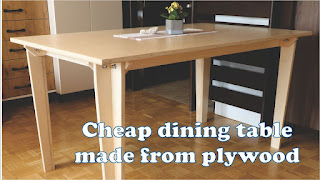Build Your Own Plywood Furniture with DIY Plans
Plywood, a versatile and cost-effective material, offers a wealth of possibilities for the discerning DIY enthusiast. Its layered construction provides strength and stability, making it an ideal choice for a wide range of furniture projects. This comprehensive guide delves into the process of constructing your own plywood furniture, offering detailed instructions, design considerations, and practical tips to ensure a successful outcome. From simple shelving units to more complex pieces, this guide empowers you to create custom furniture tailored to your specific needs and aesthetic preferences.
Selecting the Right Plywood
The foundation of any successful plywood furniture project lies in selecting the appropriate type and grade of plywood. Various factors influence this critical decision, including the intended use of the furniture, the desired aesthetic, and the project's complexity. Understanding these factors will significantly impact the final product's durability and appearance.
Types of Plywood
Several types of plywood exist, each possessing unique characteristics. Hardwood plywood, made from hardwood veneers, offers superior strength and a more refined aesthetic. It's ideal for furniture that will endure significant wear and tear. Softwood plywood, constructed from softwood veneers, is more affordable and readily available, making it suitable for less demanding projects. Consider the specific requirements of your project when making your selection. Birch, maple, and oak are popular hardwood choices, known for their strength, beauty, and workability. Pine and fir are common softwood options, offering a more economical alternative.
Plywood Grades
Plywood grades signify the quality of the veneers used in construction. Higher grades, such as A/A or A/B, feature smoother, more defect-free faces, making them ideal for visible surfaces. Lower grades, such as C/D, often contain imperfections and are better suited for less prominent areas or structural components. The selection of appropriate grades is crucial for achieving the desired aesthetic and structural integrity.
Thickness Considerations
The thickness of the plywood you choose will depend directly on the intended use and size of your furniture. Thicker plywood provides greater strength and stability, making it suitable for larger or heavier pieces. Thinner plywood is sufficient for smaller items or those subjected to less stress. Consider the weight the furniture will bear and the overall dimensions when determining the appropriate thickness. Standard thicknesses range from ¼ inch to 1 inch, with ½ inch being a common choice for many furniture projects.
Essential Tools and Materials
Before embarking on your plywood furniture project, ensure you have assembled the necessary tools and materials. Proper preparation is crucial for efficiency and a smooth construction process. A well-equipped workspace will greatly enhance the overall experience.
Essential Tools
- Measuring tape
- Pencil
- Circular saw or jigsaw
- Safety glasses
- Drill with various drill bits
- Screwdriver (both Phillips and flathead)
- Clamps
- Sandpaper (various grits)
- Wood glue
- Safety mask (for sanding and cutting)
- Level
- Square
Necessary Materials
- Plywood (appropriate type, grade, and thickness)
- Wood screws
- Wood filler
- Finish (paint, stain, varnish, etc.)
- Optional: Hardware (hinges, handles, etc.)
Designing Your Plywood Furniture
Effective design is paramount to a successful furniture-making endeavor. Careful planning ensures optimal functionality, aesthetics, and structural integrity. This section outlines key considerations for designing your plywood furniture.
Functionality and Purpose
Begin by defining the specific purpose and functionality of your intended furniture. Consider the intended use and the required storage space or seating capacity. Sketching preliminary designs can help you visualize the project and refine its functionality.
Dimensions and Scale
Accurately measure the space where the furniture will be placed to ensure proper fit and scale. Consider the dimensions of similar existing furniture to gain a sense of appropriate proportions. Use graph paper or design software to create detailed drawings and plans, specifying exact dimensions for each component.
Aesthetics and Style
Consider the overall aesthetic and style of your furniture. Will it complement the existing decor? Explore various design options, considering the use of simple lines, intricate detailing, or unique joinery techniques. Research different furniture styles for inspiration.
Construction Techniques
This section details common construction techniques used in plywood furniture building. Proper technique ensures strength, durability, and a professional-looking finish.
Cutting and Shaping
Accurate cutting is fundamental to the project's success. Use a sharp saw blade to minimize splintering and ensure clean cuts. A jigsaw is ideal for intricate shapes, while a circular saw is better suited for straight cuts. Always use safety glasses and a dust mask when cutting plywood.
Joining Techniques
Several joining techniques are employed in plywood furniture construction. Butt joints are simple but require additional support, such as screws or dowels. Dado joints create a stronger, more aesthetically pleasing connection. Pocket hole joinery provides robust hidden joinery ideal for many applications. The chosen method depends on the project's complexity and strength requirements.
Assembly and Finishing
Carefully follow your plans during assembly. Use clamps to ensure accurate alignment and secure joints. Once assembled, fill any screw holes or gaps with wood filler and sand smooth. Apply the chosen finish (paint, stain, varnish, or a combination thereof) to protect the wood and enhance its appearance. Allow ample drying time between coats.
Safety Precautions
Safety should always be prioritized when working with power tools and sharp instruments. Wear appropriate safety gear, including safety glasses, a dust mask, and hearing protection, throughout the project. Ensure your workspace is well-lit and free of obstructions. Always follow the manufacturer's instructions for all tools and materials used.
Conclusion
Building your own plywood furniture offers a rewarding experience, combining creativity, craftsmanship, and cost savings. By carefully selecting materials, planning your design, and employing proper construction techniques, you can create functional and aesthetically pleasing furniture that enhances your living space. Remember to prioritize safety throughout the process and enjoy the satisfaction of transforming raw materials into beautiful, durable pieces.


No comments:
Post a Comment